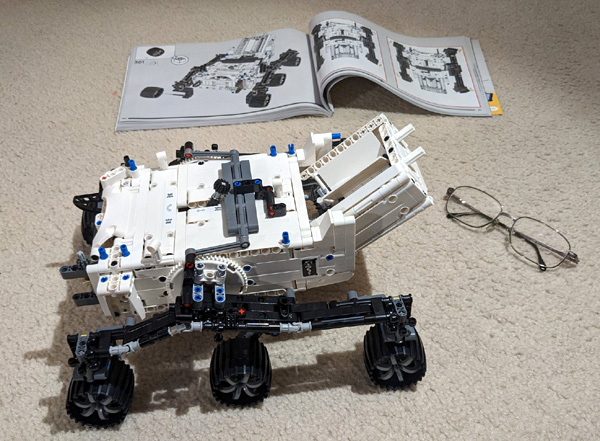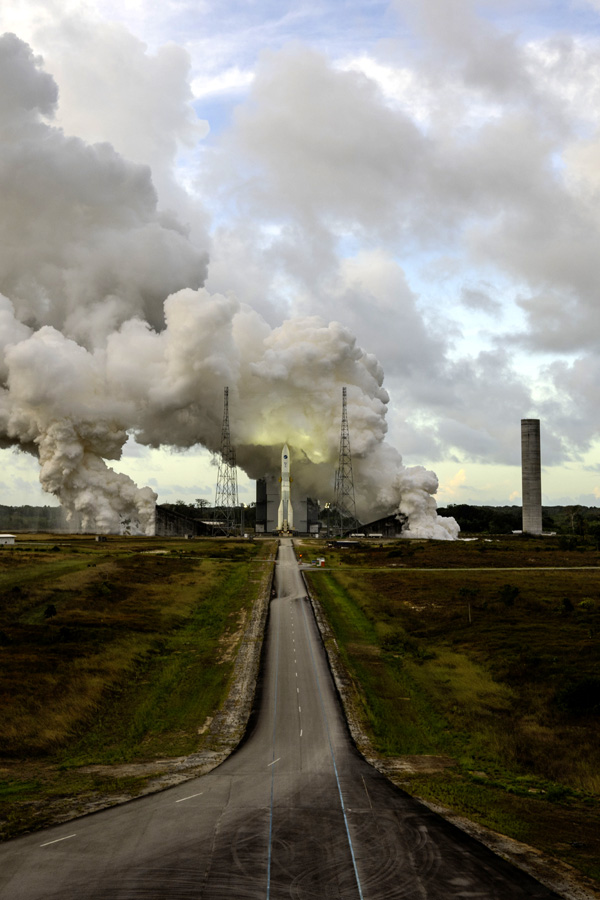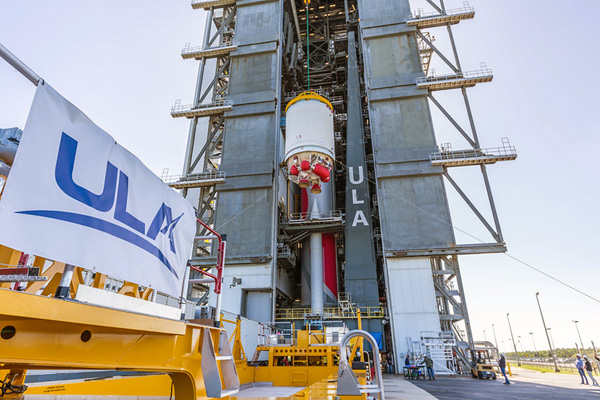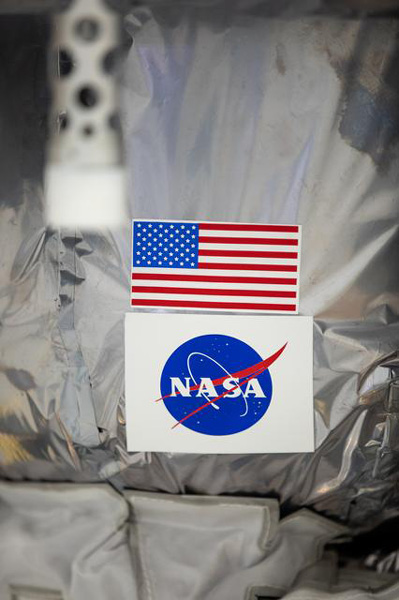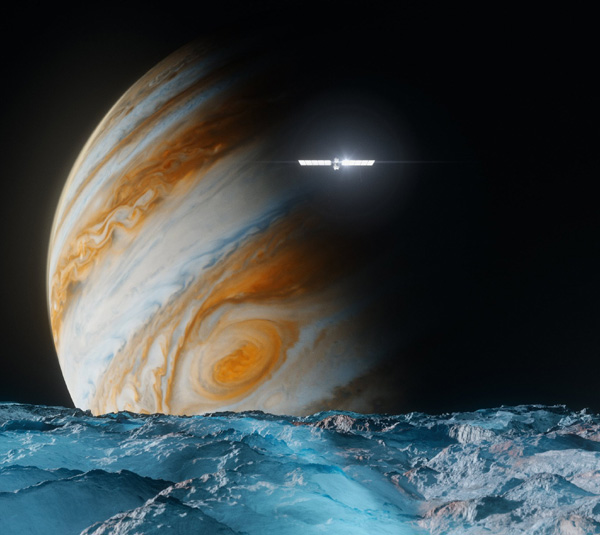 United Launch Alliance
Vulcan Cert-1: Payloads Mounted Atop Rocket for Launch (News Release)
United Launch Alliance
Vulcan Cert-1: Payloads Mounted Atop Rocket for Launch (News Release)
The payload complement for the inaugural United Launch Alliance
(ULA) Vulcan rocket is atop the launch vehicle in preparation for liftoff from Cape Canaveral Space Force Station in Florida on January 8 at 2:18 a.m. ET.
The
Certification-1 (Cert-1) flight test will launch the first Astrobotic
Peregrine commercial lunar lander into a highly-elliptical orbit more than 220,000 miles
(360,000 km) above Earth to intercept the Moon and carry a Celestis Memorial Spaceflight Payload into deep space.
Peregrine is slated to be the first private American spacecraft to be launched as part of NASA’s Commercial Lunar Payload Services
(CLPS) initiative to deliver science and technology experiments to the lunar surface. The Celestis payload includes cremated remains of the creator and beloved stars of the original
Star Trek television series and DNA samples of former U.S. presidents.
The Cert-1 cargo, already encapsulated in the composite payload fairing measuring 17.7 feet
(5.4 meters) in diameter and 51 feet
(15.5 meters) in length, was moved overnight from the payload processing facility to ULA’s Vertical Integration Facility
(VIF) adjacent to Space Launch Complex
(SLC)-41.
This morning, ULA technicians attached the lifting sling to the payload and hoisted it into the VIF for connection to the Centaur V upper stage of the Vulcan rocket, which now stands fully assembled at 202 feet
(61.6 meters) tall.
Integrated testing and a complete electrical checkout of the combined rocket and payload will be completed in the coming days while final readiness reviews and closeout activities are performed in preparation for rollout of the rocket on its Vulcan Launch Platform
(VLP) to SLC-41 for the countdown and liftoff.
For this inaugural flight, the rocket is flying in the Vulcan VC2S variant. The two-stage rocket uses two BE-4 methane-fueled engines on the booster stage, two GEM 63XL solid rocket boosters, dual RL10C-1-1A engines on the Centaur V upper stage and encapsulates the spacecraft in the standard-sized Out-of-Autoclave
(OoA) payload fairing.
Peregrine is equipped with a diverse suite of scientific instruments, technologies, mementos and other payloads from seven different countries, dozens of science teams and hundreds of individuals. The lander also carries a shoebox-sized, 2 kg
(4.4-pound) rover, called
Iris, that was built by Carnegie Mellon students to take geological images.
NASA's payload suite includes a LiDAR
(light detection and ranging) sensor to determine the Peregrine spacecraft's exact velocity and position to land, laser retroreflectors for use in determining the lander's precise location, a radiation sensor to collect information about the lunar environment and spectrometers to measure resources at the landing site and the lunar exosphere.
NASA is working with American companies to deliver scientific, exploration and technology payloads to the Moon’s surface and orbit. The science investigations and technology demonstrations delivered to the lunar surface through CLPS are part of the agency’s broader goal of returning humans to the Moon through the
Artemis program.
The Peregrine landing site is an ancient, hardened lava flow – outside of the Gruithuisen Domes, a geologic enigma along the highlands boundary on the northeast border of the Ocean of Storms, the largest dark spot on the Moon. The Domes are suspected to have been formed by a sticky magma rich in silica, similar in composition to granite.
On Earth, formations like these need significant water content and plate tectonics to form, but without these key ingredients on the Moon, lunar scientists have been left to wonder how these domes formed and evolved over time.
The spacecraft stands 6.2 feet
(1.9 meters) tall and 8.2 feet
(2.5 meters) wide. It will operate for approximately 10 days on the surface.
The Celestis mission will launch 265 flight capsules containing cremated remains, DNA samples and messages of greetings from clients worldwide on an endless journey in interplanetary space beyond the Earth-Moon system and orbit the Sun forever. Aboard are the creator of the original Star Trek television series, Gene Roddenberry, his wife Majel Barrett Roddenberry, and cast members Nichelle Nichols, the actress who played Lieutenant Nyota Uhura, and beloved actor, James "Scotty" Doohan who played the chief engineer of the
Starship Enterprise.
DNA samples of former U.S. presidents George Washington, John F. Kennedy and Dwight D. Eisenhower will also be part of the Celestis memorial payload, together with people from all walks of life, interests and vocations.
The Celestis payload will remain affixed to the Centaur V, which will be placed in a hyperbolic orbit around the Sun following completion of the Peregrine portion of the launch and subsequent propellant depletion and standard safing activities for an upper stage. It will remain in this orbit for eternity.
This is the first of two flight tests required for ULA's certification process with the U.S. Space Force. ULA has worked in close partnership with the Space Force throughout the design, development, testing and production of the next-generation rocket for assured access to space.
The Space Force selected Vulcan as the No. 1 offeror and "best value" choice in the Phase 2 National Security Space Launch
(NSSL) competition.
Source: United Launch Alliance
****
 United Launch Alliance
United Launch Alliance
 United Launch Alliance
United Launch Alliance
 United Launch Alliance
United Launch Alliance



